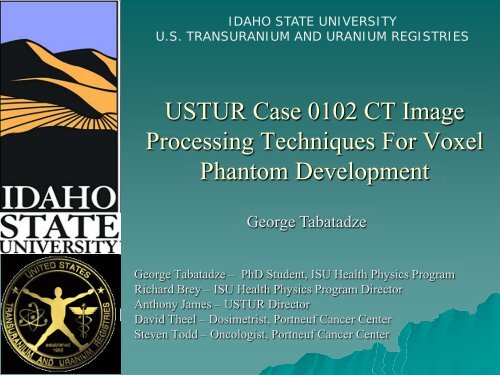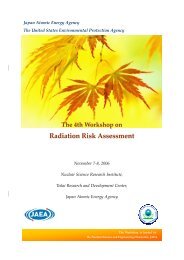USTUR Case 0102 CT Image Processing Techniques For Voxel ...
USTUR Case 0102 CT Image Processing Techniques For Voxel ...
USTUR Case 0102 CT Image Processing Techniques For Voxel ...
- No tags were found...
Create successful ePaper yourself
Turn your PDF publications into a flip-book with our unique Google optimized e-Paper software.
IDAHO STATE UNIVERSITYU.S. TRANSURANIUM AND URANIUM REGISTRIES<strong>USTUR</strong> <strong>Case</strong> <strong>0102</strong> <strong>CT</strong> <strong>Image</strong><strong>Processing</strong> <strong>Techniques</strong> <strong>For</strong> <strong>Voxel</strong>Phantom DevelopmentGeorge TabatadzeGeorge Tabatadze – PhD Student, ISU Health Physics ProgramRichard Brey – ISU Health Physics Program DirectorAnthony James – <strong>USTUR</strong> DirectorDavid Theel – Dosimetrist, Portneuf Cancer CenterSteven Todd – Oncologist, Portneuf Cancer Center
Outline Introduction– History of the <strong>USTUR</strong> case <strong>0102</strong>– <strong>CT</strong> data acquisition Current work – <strong>Image</strong> <strong>Processing</strong>– Segmentation of the <strong>USTUR</strong> case <strong>0102</strong> <strong>CT</strong> images Automatic (semi-automatic) Segmentation Technique Development of the <strong>USTUR</strong> case <strong>0102</strong> voxelphantom Possible applications of the <strong>USTUR</strong> case <strong>0102</strong>computational phantom
Introduction The United States Transuranium and UraniumRegistries (<strong>USTUR</strong>) is a resource of human tissuevoluntarily donated by past workers with documentedoccupational actinide exposures. <strong>USTUR</strong> <strong>Case</strong> <strong>0102</strong>:– a substantial accidental intake of 241 AmO 2– Half of this skeleton is encased in tissue equivalent plasticand serves as a unique “human phantom” for the calibrationof whole body counting systems at United StatesDepartment of Energy (USDOE) and other laboratorieshttp://www.ustur.wsu.edu/
<strong>CT</strong> Data Acquisition <strong>USTUR</strong> <strong>Case</strong> <strong>0102</strong> Phantom was scanned at KadlecMedical Center’s Diagnostic Imiging Unit– GE Lightspeed 16 scannerStuart E. Gunn (Dedication in Health Phys. 49(4), 1985)
<strong>Image</strong> <strong>Processing</strong> (Segmentation)Cortical BoneLight TissueBone CavityRegular TissueAir Pockets
<strong>Image</strong> <strong>Processing</strong> (Segmentation) Resolution of <strong>CT</strong> images is 0.6 mm Resolution after the segmentation process is 0.2 cm
Three Dimensional <strong>Image</strong>s (Head)
Three Dimensional <strong>Image</strong>s (Upper Thorax)
Three Dimensional <strong>Image</strong>s (Upper Arm)
<strong>Voxel</strong> Phantom Development The voxel phantom development steps:– The 3D surface models for each phantom (Non-UniformalRational B-Spline, NURBS) are created with Rhinoceros®software.– <strong>Image</strong>s are voxelized using MATLAB® into virtual(computational) phantom.
Applications <strong>USTUR</strong> <strong>Case</strong> <strong>0102</strong> voxel phantom represents:– Bone structure of the head, torso, arm, and leg phantoms– Tissue (tissue equivalent material) structure, thickness,density variability– Radionuclide content of bones
Applications <strong>Voxel</strong> phantom can be imported into a Monte Carlocode for radiation transport Following codes are considered:– MCNPX– EGSnrc– GEANT The most “appropriate” code can be chosen based onthe following criteria:– Ability to process large number of voxel arrays– Data manipulation within the code– Any other issues these codes may have with a voxelizedgeometry
Applications• Experimental response of external planar germaniumdetectors variously positioned over the extremitiescan be simulated
Applications Finally,Counting efficiency of different detector types andconfigurations can be calculated for people ofdifferent anatomical build and body size




